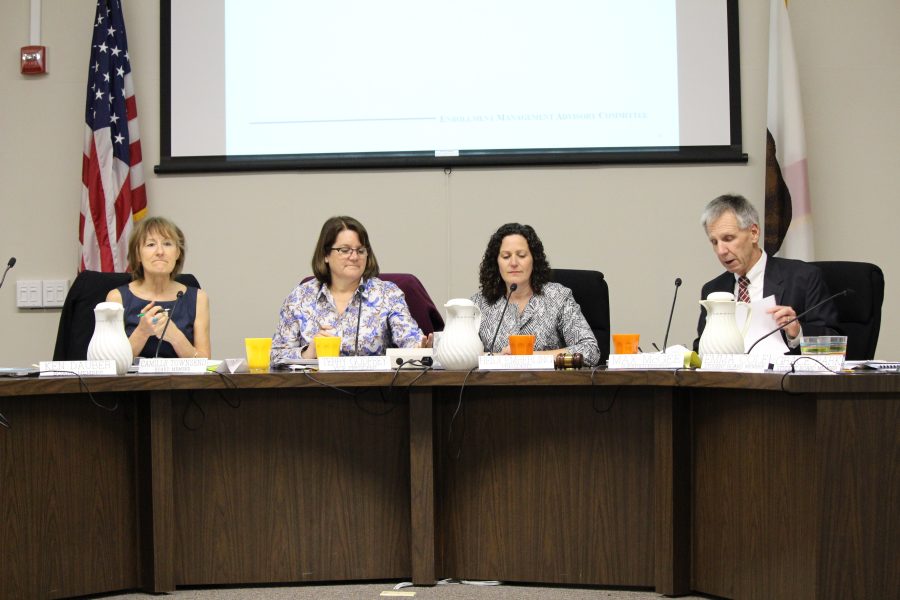In the face of a highly emotional debate among parents at a Palo Alto Unified School District (PAUSD) School Board meeting, a majority of the board indicated its intention to reject Superintendent Max McGee’s proposal to create a new PK-12 school at the Cubberley Community Center.
Board members Ken Dauber, Terry Godfrey and Melissa Baten Caswell agreed that the district does not need a third high school. However, president of the board Heidi Emberling and trustee Camille Townsend expressed their support for McGee’s recommendation to create a committee which would in part determine the feasibility of opening a school at Cubberley.
The original Cubberley plan was inspired by the Enrollment Management Advisory Committee (EMAC), which enthusiastically presented the idea of a third, more innovative high school late last year. McGee believes that the Cubberley school, if approved, would stimulate parallel advancements in project-based education at Palo Alto High School and Henry M. Gunn High School.
Dozens of parents spoke passionately at the meeting Tuesday, Jan. 26 about their students’ experiences whilst the board looked on. One parent set the tone for the discussion, after bursting into tears while explaining her daughter’s experience at David Starr Jordan Middle School.
“I didn’t come here with famous quotes, but I did bring one quote from my seventh grade daughter at Jordan,” parent Yanhong Lin said. “She said, ‘The time I learned the most was from a 5-minute YouTube video on fossil fuels.’ If you asked me to come and present to you last year, I would have told you that there is no reason to look into a new school. But, things have changed.”
With the board still divided on the idea of creating a new secondary school, select members will go to vote on a committee next month. Townsend, one of the members who will vote next month, said that the creation of a new secondary school will help foster innovation that will spread to Paly and Gunn.
“I believe a significant number [of students and parents] believes that we should explore alternate options in education,” Townsend said. “You don’t need to commit to anything until you explore it. We’ve got to take this energy from the community any capitalize on it. We are taking the next step to allow teachers and students to find their passions.”
However, as the peak number of students is projected to arrive in two years, before the Cubberley school is estimated to be completed, some community members, including Godfrey, believe focus should be placed on existing schools.
“I didn’t come here with famous quotes, but I did bring one quote from my seventh grade daughter at Jordan,” parent Yanhong Lin said. “She said, ‘The time I learned the most was from a 5-minute YouTube video on fossil fuels.’ If you asked me to come and present to you last year, I would have told you that there is no reason to look into a new school. But, things have changed.”
“I don’t want to see a high school at Cubberley,” Godfrey said. “I think we should focus on making sure that all 4,000 high school students get the same rich experience rather than making a smaller school that only houses maybe 500 to 600 students.”
Paly and Gunn currently enroll 1,979 and 1,886 students, respectively, figures exceeding the maximum enrollment recommended by EMAC’s findings which state that learning efficiency begins to fall when enrollment is above 1,700 students. According to Caswell, larger schools do not necessarily affect learning.
“There is no cut and dry that after you hit a certain size the schools don’t work anymore,” Caswell said. “If we can create more connectedness and smaller learning communities, we will have greater engagement.”
Furthermore, critics of the proposal claim that the innovative ideas formed in the laboratory setting of the new Cubberley school will not cross-pollinate over to existing schools, as current high schools do not always follow the other’s practices.
“What we’ve not done well in the past is take what works well in one school and proliferate it into other schools,” Godfrey said. “An easy first step is to step back and think about what works well. Then, we can figure out how to make it work in another school.”
Ahead of next month’s vote, McGee hopes that Palo Altans will keep an open mind to all possibilities, in order to not unnecessarily close of possible options.
“We need to be more comfortable with ambiguity,” McGee said. “So many individuals are quick to rush to judgement and have their minds made up and the solutions figured out before they solve the problems. Lets figure out what the problems are before we determine the solutions.”

